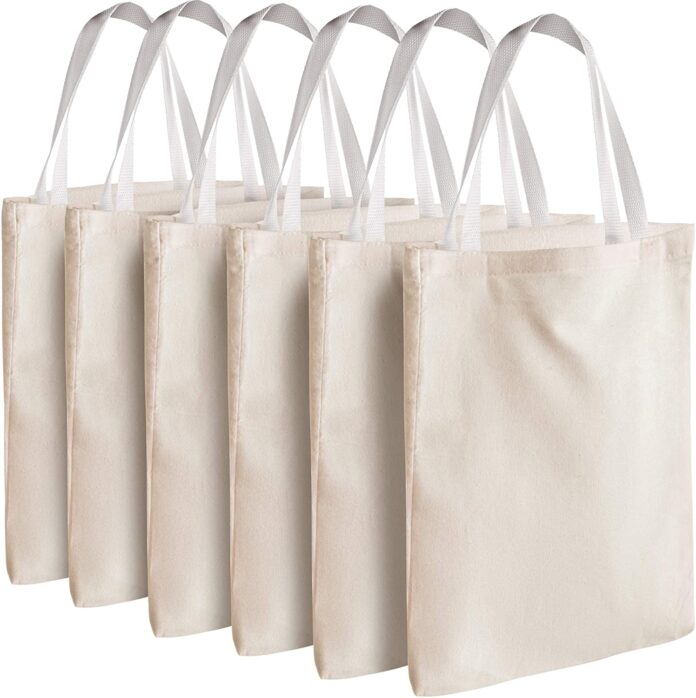You get to Imtiaz for your weekly shopping. Or if you’re in Lahore instead of Karachi, maybe you go to Al-Fatah. You lock your car and go inside. Everything is working smoothly as you get your trolley and thread your way through the aisles.
A couple of hours later you’ve successfully checked off your entire list. There wasn’t a big rush, you managed to get a small treat for yourself and now you’ll be home in time for lunch.
As the cashier checks out your items, he asks a dreaded question.
“Bag add karna hai?”
That is when you remember … you forgot your shopping tote bag at home again. You know, the big cloth ones that supermarkets give out to be seen as environmentally friendly after the government has banned plastic. You look at your shopping haul and realise you can’t carry it in your arms, so you reluctantly agree. At home, you unload your groceries and stuff the tote bag into the same drawer where all of your other tote bags are kept. Next time, you think, next time I won’t forget. Except you will, and you’ll pay for another tote back and the vicious cycle will continue.
Of course, even if you managed to remember your tote bag every time, it would take 54 years of using an organic cotton tote nearly 20,000 times to offset the environmental impact of production. These tote bags in grocery stores, and the concept of tote bags in general, is a strange one.
Because these once very practical inventions have now also become fashionable items to carry around, with tote bag designers making custom bags. As a method to carry things, they are fashionable and versatile. Yet their promotion as an environmentally friendly part of life and as a replacement for plastic bags is not quite the simple matter one might think it to be.
The ban and ‘unban’ on plastics
A cliché Mark Twain quote comes to mind; “Quitting smoking is easy. I’ve done it hundreds of times.” It’s as if the various governments in Pakistan relate to the sentiment while talking about banning plastic bags. Banning plastic bags is easy; the government has done it multiple times. Effectively banning plastic, however, is not that easy.
The most recent ban in Karachi was decided on May 20, 2022. This was done through a letter sent to the Administrator, Karachi Metropolitan Corporation from the Planning and Development Department, Government of Sindh. It recommended the implementation of the decisions taken by the government agencies regarding a complete ban on polythene bags.
The resolution further requested KMC to approve a complete ban on the manufacture, sale and use of polythene bags in the city. If not followed, under Section 15 (132) of the Sindh Local Government Act 2013 and Schedule VI, the KMC has jurisdiction to take legal action against violators after June 15. At this point, we are well beyond the 15th of August, two months since the deadline – and the ban on plastics in Karachi is nowhere near implementation.
The situation, however, is better in other cities such as Lahore and Islamabad where the earlier ban is followed a bit more seriously in most areas, if not all. Second-tier cities, however, still use an abundance of plastic bags.
According to the Pakistan Plastic Manufacturers Association (PPMA), there are nearly 8,000 industries and units that make products related to plastic. The largest among this group of manufacturers are those that produce polyethylene bags.
Representatives of the PPMA have said that the exact size of the plastic bag manufacturing industry cannot be determined, because Pakistan churns out thousands of tonnes of this product every single day. Large chains of fast food and shopping malls often require up to 80 tonnes of shopping bags every single month. Because of a lack of political will behind its implementation, the ban on plastic bags has been an on-and-off phenomenon.
Provincial governments regularly fail to implement their own bans and go back on them when they strike a deal with either shop owners or the plastic bag industry.
“Making the rules is one thing, but there’s been no effort in implementing the rules. If you don’t make sure the ban is carried out. What’s the use?” says Naheed Mooraj, the entrepreneur behind Candle Works and an avid user of tote bags. “Ofcourse tote bags are underutilised, you see more people with plastic bags than tote bags when you go out.”
From ice to fashion to branding: a history
The verb “to tote” simply means to lug or to carry by hand. Totes are traditionally made of canvas, however, the definition of a tote does not define the material. Therefore, a tote can be any material as long as it can be used to tote.
The first formally defined tote bag came into being in 1944 by the LL Bean Company, known for its outdoor equipment and totes. The inspiration had been drawn from ice!
They had come up with a simple water resistant canvas bag that could be used to transport ice from the car to the freezer. Users realised early on that while the bag was water resistant, its usage didn’t have to be limited to ice. People started expanding the usage of the bag and used them while running household chores or picking up groceries.
If you’re interested in what the original tote bag looked like, just check out the L.L. Bean Boat Bag. It’s based on the original design of the ice bag and remains popular. The history of totes gets more glamorous when you find out its linkages with Birkins. Jane Birkin’s original tote was an oversized woven basket that she used to carry her belongings with ease. While the basket was useful in carrying her things and snacks for her daughters, the material wasn’t the easiest to carry around.
However, once while flying from Paris to London, Birkin met Jean-Louis Dumas, the chief executive at Hermes. He offered her to make a new tote bag, the Birkin Bag. This made totes not just an item of utility, but also a must-have fashion item.
In the 1980’s, however, The Stand, a bookstore in New York City introduced its own design for a tote made of natural cotton duck canvas. It advertised the store’s name, address, and slogan. “18 miles of books”, read the tote. The trend picked on. Several other bookstores, artisanal brands and so on started their own versions. Thus, making the totes a form of personalised statement and expression. In a way, the totes helped define a characteristic of the wearer.
The tote rush
The concepts of totes are not new to Pakistan. Families would be seen lugging soft plastic baskets and big bags of sturdy material across traditional budh and itwar bazaars carrying groceries and other finds.
“I’ve always carried a bag with me whenever I went to the bazaar. It would simply be easier to put everything in one big bag than to carry five small bags of different vegetables, one bag of masala packets, and a toy I’d buy for my son,” says Mehwish Khan, a resident of Karachi. Khan adds, “People would be selling strong material bags and big plastic bags at these bazaars.”
Supermarkets picked up on this concept too. Following the various bans on plastic bags, these stores started selling sturdier bags made out of cloth. Since people would have no option but to buy the tote bag sold by the grocery store itself, they would end up doing so. While some individuals appreciated the efforts to reduce pollution, some individuals planned their shopping destination based on whether they sold plastic bags or not.
Kamran Ahmed, a resident in Karachi explains, “To save myself from all the hassle, I started going to Imtiaz. They always have plastic bags. More importantly, you don’t have to buy them. I reuse those bags multiple times. In fact, we have a plastic bag full of plastic bags at home.”
What types of carrier bags are available?
Low density polythene bags (LDPE) are the regular plastic bags you find at stores. The quality, however, can vary. Plastic bags formed from an LDPE plastic melt, which is blown and sealed to form a bag.
Non-woven polypropylene bags are a bit more stronger and durable. These are usually bigger than the plastic bags and are not single use bags. They are formed from molten filament of PP which is spunbonded but not woven. These are gaining popularity in Pakistan.
Woven polypropylene (PP) bags are made by weaving PP fibres. They’re stronger and more durable than plastic bags. Tote bags sold by supermarkets are often made of this material. Recycled polyethylene terephthalate (PET) bags are also available sometimes. These are plastic bags obtained from weaving molten fibres from recycled PET pellets
Paper bags were a little more popular in the past and are rarely seen lately as they tear with weight. These are made of craft paper which is glued to form bags. Lastly, we have textile bags. They’re made of woven cotton or jute. They can be used multiple times. They can be made of organic or conventional textiles.
In Pakistan’s case, tote bags (or promotional give-away bags) are usually made from polypropylene ‘spunbond nonwoven’ material, which is a cheap alternative to cotton bags. They can cost anything from Rs 20 to 50 per bag.
“A cotton tote bag would be at minimum, a hundred rupees. The spunbond materials made here are primarily for mattress covers and sanitary wear that include diapersm and while they are usable for tote bags, the ‘quality’ used by the tote bag industry means they will soon wear-out, tear or deteriorate,” says Abid Omar, Director at Duraprints by Syntech Fibres, a digital textile printer for fashion and interiors.
Omer adds that while these nonwovens are produced in large scale industry, the tote bag manufacturing sector is largely in the promotional give-away sector which works in cottage industry or ‘unorganised sector.’ “This is due to the small volumes involved with orders being in hundreds or at most thousands of units, involving lots of customisation, which is not cost-competitive for the organised sector.”
Instagram, vanity, and statements
Tote bags, however, have become a style statement lately in Pakistan. Every community pop up features some stalls or stores carrying totes.
“There definitely has been an increase in tote bag usage over the past 3-4 years. They’re handy, carry a distinct personality and are super convenient to use. I also feel there could be a direct correlation between festivals/events like Daachi etc that have promoted the use of tote bags,” says Sonya Rehman, an art and culture journalist and founder of From Lahore with Love, a venture which not only aims to revive the joy of snail-mail in Pakistan through a series of postcards, but also pays homage to Lahore’s cultural heritage.
The designs of a tote bag also pull consumers in. “I think people buy tote bags because it’s cool, is an extension of their personality and make such a lovely, subtle statement! Besides, tote bags are eco-friendly and durable,” says Rehman.
“Tote bags are the next journals/stationery — you can’t help but instinctively pick up a pretty tote bag no matter how much you have lying around at home,” adds Rehman. While consumers do tend to use them, it is important to note that most of the time they are not used to their full potential.
In 2018, a study by the Ministry of Environment and Food of Denmark and Danish Environmental Protection Agency released a research report on the number of times a carrier bag should be reused.
“For all carrier bags, reuse as many times as possible before disposal is strongly encouraged. The calculated number of reuse times might be compliant with the lifetime of PP, PET and polyester carrier bags, but might surpass the lifetime of bleached paper, composite and cotton carriers, especially considering all environmental indicators,” reads one section of the report.
The very high number of reuse times scored by cotton and composite bags is primarily due only to the ozone depletion impact category, for which the cotton production dataset provides larger impacts than the reference LDPE carrier bag.
An organic cotton tote needs to be used 20,000 times to offset its overall impact of production, according to the report. That equates to daily use for 54 years — for just one bag! This is primarily because organic cotton doesn’t use fertilisers and so production is around 20 to 40% lower yield than conventional cotton. Conventional cotton bags must be used at least 7100 times.
“You can tell people about virtual water (which is water hidden in products that goes into their making. Buyers rarely account for how water friendly a product is) and the footprint of growing cotton and using its products, and how conscious they should be. Because then there’s this whole debate that moves beyond bags, moves beyond things to wear; the fast fashion concept. And that is another very long debate that we should continuously have anyway,” says Salam.
“While the environmentally conscious are carrying cotton tote bags, they are ignorant about their environmental impact which is manifold more than a simple plastic bag… at best it is a cultural signifier that they too ‘care for the environment’ while becoming a walking advertisement,” argues Omar.
What this means is, if you do end up buying a cotton tote for environmental reasons, you should use it as much as possible and not buy multiple bags for vanity. To credit her customers, Rehman adds that the totes she sells are made of cotton and are durable. She says, “I introduced my totes to my product line a few years ago, I’m always pleasantly surprised to meet friends/strangers who continue using my totes that they bought very early on.”
“No, I don’t think people buy tote bags for vanity purposes. People who are conscientious people, who are aware of their environment are people making the decision to use tote bags even if it’s just them doing it. There’s nothing about vanity in it,” states Mooraj.
The state of plastic — is there another way out?
The environmental concerns caused by shopping bags is an international phenomenon, which is why Oxo Biodegradable technology was introduced. The industry at first thought they had a saviour. Two or three other technologies had been introduced before this, but this proved to be the most successful and feasible one yet.
“People don’t have any concept of virtual water and the longevity of recyclable material, how that material can become a part of the earth so right now [awareness] is just to move away from single use plastic. There’s nothing wrong with reusing plastic, as long as it doesn’t become part of trash,” explains Salam patiently. Indeed, single use plastic bags’ impact on the environment is severe. They make their way into the digestive system of animals both on land and sea, they add to pollution, and clog drains.
With the help of this tech, the hundreds of years that plastic takes to degrade was brought down to a matter of a few months. This is why it is called controlled life plastic technology. The way it works is that it is also made in the shape of plastic grain, and during the process of making plastic, a specific amount of this material is added, which makes the plastic environmentally friendly.
In Pakistan, it was introduced on 1 April 2014, and other than Punjab and Islamabad, using this technology was made mandatory under law in the rest of the country. Meanwhile, this technique started being used in the preparation of plastic bags in Lahore and other cities of the Punjab. But the problem was once again the market, and how it responded. The extra cost was unacceptable and the tech quickly failed in Pakistan, and since there were no compliance laws, manufacturers stuck to their old plastic.
“Get people to start using reusable containers for their groceries, for example yogurt can be purchased in your own container rather than in a poor quality ‘thali’,” says Omar.
He adds, “Our polyethene industry uses the worst possible PE [polythene] which are not recyclable, instead of the HDPE [high density polyethene]? They also stamp the bags with “oxo biodegradable” where in reality it’s nothing more. And most importantly, plastics are not the enemy, it is rather our culture.“
Of course, the tote bag industry is nothing like the plastic bag industry. It is utilitarian for sure, but also has a very particular presence as a fashionable item. Whether you’re wearing a Birkin, a Goyard or a cotton tote from Liberty books with your favourite Shakespeare quote, the reality is that it would most likely remain the mainstay of fashion in Pakistan. For an environmentally friendly solution to this problem, there are other avenues that must be explored.
And explored they must be. Tomorrow, in the early hours of the morning, on the way to school, or, if you’re a parent, to drop your kids to school, notice how still the city is. In the sky, the sun will be bright but not overly so, the streets will be quiet, people stirring slowly but the only things that will be taking flight energetically will be white plastic bags, destroying both the serenity and beauty of the city.


























some history lessons right here ‘In the 1980’s, however, The Stand, a bookstore in New York City introduced its own design for a tote made of natural cotton duck canvas. It advertised the store’s name, address, and slogan. “18 miles of books”, read the tote. The trend picked on. Several other bookstores, artisanal brands and so on started their own versions. Thus, making the totes a form of personalised statement and expression. In a way, the totes helped define a characteristic of the wearer.
‘
I have perused every one of your posts and all are exceptionally enlightening. Gratitude for sharing and keep it up like this.
사설 카지노
j9korea.com